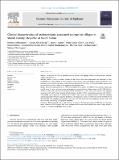| dc.contributor.author | Colebundersa, Robert | |
| dc.contributor.author | Abd-Elfarag, Gasim | |
| dc.contributor.author | Carter, Jane Y. | |
| dc.contributor.author | Oloree, Peter Claver | |
| dc.contributor.author | Puokf, Kai | |
| dc.contributor.author | Menona, Sonia | |
| dc.contributor.author | Siewea, Joseph Nelson Fodjo | |
| dc.contributor.author | Bhattacharyyag, Samit | |
| dc.contributor.author | Ojoke, Morrish | |
| dc.contributor.author | Logorai, Makoy Yibi | |
| dc.contributor.author | Lakoh, Richard | |
| dc.date.accessioned | 2022-02-01T20:31:55Z | |
| dc.date.available | 2022-02-01T20:31:55Z | |
| dc.date.issued | 2018-11 | |
| dc.identifier.citation | Colebunders R, Abd-Elfarag G, Carter JY, Olore PC, Puok K, Menon S, Fodjo Siewe JN, Bhattacharyya S, Ojok M, Lako R, Logora MY. Clinical characteristics of onchocerciasis-associated epilepsy in villages in Maridi County, Republic of South Sudan. Seizure. 2018 Nov;62:108-115. doi: 10.1016/j.seizure.2018.10.004. Epub 2018 Oct 5. PMID: 30340162. | en_US |
| dc.identifier.other | https://doi.org/10.1016/j.seizure.2018.10.004 | |
| dc.identifier.other | PMID: 30340162 | |
| dc.identifier.uri | https://repository.amref.ac.ke/handle/123456789/564 | |
| dc.description | © 2018 The Authors. Published by Elsevier Ltd on behalf of British Epilepsy Association. This is an open access article under the CC BY-NC-ND
license (http://creativecommons.org/licenses/BY-NC-ND/4.0/). | en_US |
| dc.description.abstract | C T
Purpose: To describe the clinical manifestations of persons with epilepsy (PWE) in onchocerciasis endemic
villages in South Sudan.
Methods: During a survey in Maridi County in May 2018, PWE were interviewed and examined in their
households by a clinical o cer or medical doctor. Onchocerciasis-associated epilepsy (OAE) was de ned as 2
seizures without any obvious cause, starting between the ages of 3–18 years in previously healthy persons who
had resided for at least 3 years in the onchocerciasis endemic area.
Results: Seven hundred and thirty-six PWE were included in the study; 315 (42.8%) were females; median age
was 18 years. A variety of seizure types were reported: generalized tonic-clonic seizures in 511 PWE (69.4%),
absences in 15 (2.0%), focal motor seizures with full awareness in 7 (1.0%), focal motor seizures with impaired
awareness in 25 (3.4%), brief episodes of hallucinations in 316 (43.9%) and nodding seizures in 335 (45.5%).
The median age of onset of all seizures was 10 years, and 8 years for nodding seizures. PWE with nodding
seizures presented with more cognitive disabilities. The diagnostic criteria for OAE were met by 414 (85.2%) of
the 486 PWE with complete information. Eighty (11.0%) PWE presented with Nakalanga features. Only 378
(51.4%) PWE were taking anti-epileptic treatment.
Conclusion: PWE presented with a wide spectrum of seizures. The high percentage of PWE who met the diagnostic
criteria for OAE suggests that better onchocerciasis control could prevent new cases. Urgent action is
needed to | en_US |
| dc.description.sponsorship | The European Research Council (ERC) grant number 671055, project title NSETHIO | en_US |
| dc.language.iso | en | en_US |
| dc.publisher | Elsevier | en_US |
| dc.subject | Onchocerciasis | en_US |
| dc.subject | Epilepsy | en_US |
| dc.subject | Nodding syndrome | en_US |
| dc.subject | Nakalanga syndrome | en_US |
| dc.subject | Ivermectin | en_US |
| dc.subject | Treatment | en_US |
| dc.subject | Maridi | en_US |
| dc.subject | South Sudan | en_US |
| dc.title | Clinical Characteristics of Onchocerciasis-associated Epilepsy in Villages in Maridi County, Republic of South Sudan | en_US |
| dc.type | Article, Journal | en_US |

